Warren Dwight Allen states in Philosophies of Music History, "The neglect of music with words is the most glaring defect of modern textbooks on musical appreciation."1 Song has primarily been analyzed for its forms rather than for the way in which the composer has attempted to express the words. "Music and drama [and hence, the relationship of music and words] have therefore gone their respective ways in American music education."2 A prime concern of music theorists has been with the ". . . grammar and syntax of music rather than with its meaning."3
Because of Stravinsky's strong feelings regarding the expressive powers of music and the relationship of music and ideas, it is of special value to determine how he met this aesthetic problem in the difficult task of setting ancient Latin to music written in a variety of modern styles.
Writing in his autobiography in 1936, Stravinsky declared:
. . . I consider that music is, by its very nature, essentially powerless to express anything at all, whether a feeling, an attitude of mind, a psychological mood, a phenomenon of nature. . . .
If . . . music appears to express something, this is only an illusion and not a reality.4
Stravinsky had already shaken the world of music in 1923 with his Octet for Wind Instruments with its objectivity and its return to the forms of the earlier centuries. Now the composer put into words the aesthetic principles of Neo-Classicism, and he saw this aesthetic principle as applying not only to instrumental music, but also to the setting of texts to music: "From the moment song assumes as its calling the expression of the meaning of the discourse, it leaves the realm of music and has nothing more in common with it."5
In 1962, however, he amended his previous statements, explaining, "[Regarding that] overpublicized bit about expression . . . It was aimed against the notion that . . . exact sets of correlatives must exist between a composer's feelings and his notation . . . but even the stupider critics could have seen that it did not deny musical expressivity, but only . . . a type of verbal statement about musical expressivity. . . ."6 Some recent criticism sees validity in Stravinsky's modification of his original statements. Rodriguez, for example, writes, "A few critics are obsessed with his own self-explanations, forgetting the notorious fact that musicians are most fallible when they venture to elucidate their work through . . . the spoken or printed word that is . . . strange to them."7
In 1926-7, when Stravinsky composed his opera-oratorio Oedipus Rex, he chose Latin as the language of the libretto and Oedipus was followed by other settings of Latin texts, among them Symphony of Psalms, Threni, and Canticum Sacrum. By using Latin, he had avoided being bound to the text. "What a joy it is to compose to a language of convention . . ." he wrote. "One no longer feels dominated by the phrase, the literal meaning of the words. . . . The text . . . becomes purely phonetic material for the composer. He can dissect it at will and concentrate all his attention on . . . the syllable."8
"It is this . . . which has often caused Stravinsky to ignore the text in his setting. . . . And it is for this reason that he has most often chosen Latin so that the language would not interfere with demands of the music," Hart declares in his study of compositional techniques in Stravinsky's choral works.9 Tansman found that "his treatment of the text in Oedipus Rex corresponds exactly to his theoretical conception,"10 and Schaeffner adds, "In fact, the words were not of any importance to Stravinsky; all he needed was the possibility of repeating them at will no matter how idiotic they might sound. . . ."11
There is no doubt that in Oedipus Rex Stravinsky sought and achieved freedom from dependence upon word accents and that he frequently "dissected" the text as "phonetic material," concentrating his attention on the primary element—the syllable. But did Stravinsky, in fact, choose to ignore his Latin texts? He used Latin, rather than Greek, he said, "because I had no notion of how to treat Greek musically (or Latin, Latinists will say, but there I did at least have my idea)."12 Stravinsky had studied Latin as a youth and, while working on Oedipus Rex, found that his knowledge of Latin was revived. Therefore, although the vast majority of his audiences cannot understand the texts, Stravinsky did. Although he voiced opposition to the translation of texts, saying ". . . Do not change the sound and the stress of words that have been composed to precisely certain music at precisely certain places,"13 a literal translation is essential in seeking the specific relationships of music and words.
Oedipus Rex14
Cocteau's concise libretto suggests Oedipus' personality—his benevolence, quickness to anger, pride, and desire for truth. His hubris is emphasized by the fact that the only protagonist in addition to Oedipus to use the word "ego" is the Messenger. Figure 1 illustrates the manner in which the word is passed over in this case:15
Fig. 1. Rapid, unaccented treatment of word "ego" in the Messenger's part.

In Oedipus' solos, the great stress placed on this word exemplifies his self-assurance and pride and through the employment of accents and melismas represents a form of "word-painting." (See Fig. 2.)
Fig. 2. Emphasis on word "ego" in Oedipus' role.
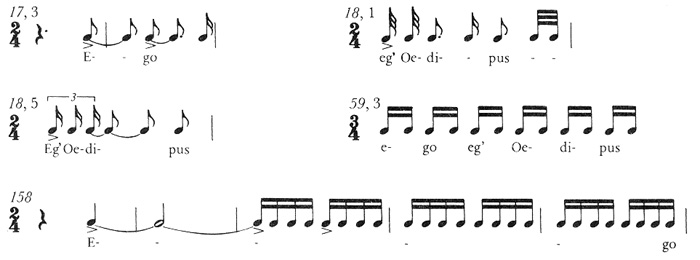
The chorus parts of Oedipus are generally stable, covering a limited pitch range with few consecutive large melodic intervals. A notable exception—and the only one in the score—is at 21 when there are sudden octave displacements, sometimes with false relationships (D-flat against D) sung "f" or "ff" with woodwind, brass, and piano accompaniment. These last for five measures until, at the end of this passage, there is a diminuendo, the brasses and the piano rest, the celli play "p," dolce cantabile, the displacements and false relationships disappear, and there is a resolution to an E-flat major triad. This effect is sudden and marked. The words at this point are:
"Quid fakiendum, quid fakiendum, Oedipus, ut liberemur?"
["What shall we do, what shall we do, Oedipus, to be freed?"]
The discords and the "f" last until the word "liberemur" when the chorus is "freed" from the harshness and violence of the previous measures. There is a quiet resolution to the major triad. Stravinsky has used change in dynamics, orchestration, melodic intervals, and movement from dissonance to consonance in this word-music relationship (see Example I).
Ex. I. "Quid fakiendum. . . ." (Sudden "diminuendo," end of discords, and large melodic intervals to represent "liberemur.")
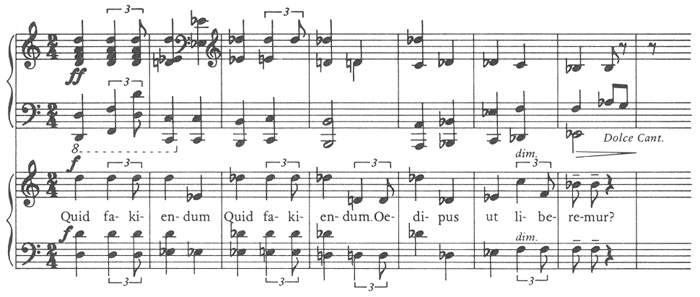
Another example of word-music relationship which uses several parameters—in this case, dynamics, melody, and orchestration—is at 94, 7-8, during Jocasta's recitative. She has sung quietly ("p") until then, calming Oedipus, the accompaniment based on the g minor chord. At the words "clamare," "ululare" ["clamoring," "howling"], there are crescendi, a change of dynamics in the orchestral accompaniment to "f," and diminished seventh arpeggios played on the harp and piano, which, when combined with the melodic motif, represent an imitation of the ideas of the words (see Example II).
Ex. II. "Clamare, ululare." (Melodic contour, "crescendi," change in orchestration to suggest "howling," "clamoring.")

Among all the usual methods of relating words and music, tonal images are probably the most obvious. The specific words suggest the setting. This can be accomplished through imitation of sounds or motion although more subtle images are also employed. Stravinsky states that he was "fascinated" by the whole subject. "I have used such images myself," he declared, "for example in the 'false relation' of the tritone at falsus pater in Oedipus Rex."16
Several other examples of tonal images which use only one musical device can be found in the score. Creon's aria, "Respondit deus," is strong and emphatic. At 33, the dynamic markings of the vocal part suddenly change to "p" (the instruments play "pp") for the first time in the song. The words here are "Thebis peremptor latet" ["In Thebes the slayer is concealed"], the softness emphasizing the image of the murderer's secret presence.
Jocasta's aria contains a passage (104, 5 - 106) with a vocal ostinato as the tone d' is repeated twenty-nine times—an unusual melody and one which occurs nowhere else in the score. The words here are, "Oracula, oracula, mentita sunt oracula, mentita sunt, mentita sunt, oracula." As she declares, "Oracles ever lie, ever lie . . . ," she is "ever" singing the same tone.
Rhythm is used at times to represent the ideas of specific words. As Oedipus sings, "I am afraid suddenly," the sudden speed of the sixteenth note triplets paints the word subito ["suddenly"]:
Fig. 3. Sudden, rapid notes to illustrate subito.

(The same melody is used starting at 129 and at 130 to different words without this device, emphasizing the fact that the speed with which "subito" is sung is based on the meaning of the word.)
A similar use of rhythm exists at 68, 5-6 when the Chorus sings:
Fig. 4. Rapid notes after pauses to illustrate idea of "quickly."

Specific word-music relationships in Oedipus Rex were found to be based on a number of parameters—rhythm, dynamics, melodic contour, discord, intervallic structure, and orchestration. In a number of examples, only one technical device is used to create the relationships, although as many as four may be used at one time. Dynamics and melodic contour are the most frequently employed aspects of composition in the creation of these examples of the literal setting of words.
Symphony of Psalms17
Stravinsky prefaced the score of Symphony of Psalms with the following instructions: "The words of the Psalms are those of the Vulgate and should [always] be sung in Latin." Certainly the deeply moving spirit of the work and the associations it calls forth would be affected if it were sung in the vernacular.
At 9, 1-4 of the first movement, the psalmist cries out, "Ne sileas!" ["Do not be silent!"]. The music, until this point, has been performed cantabile expressivo and the dynamics have been mostly "mf" or "p." Suddenly, all changes. Every note played by the second piano is accented, the score is marked "f" and ben marcato, the flute, which has primarily played sustained tones parallels the piano, playing sixteenth note figures. The "Ne sileas" is expressed by additional sound created through a combination of increased intensity and more notes per beat.
"Quoniam advena ego sum" ["For I am a stranger"], the text continues "et peregrinus" ["and a wanderer"] "sicut omnes patries mei" [''as were all my fathers"]. At "peregrinus," 11, 2-6, the melodic structure of the choral parts changes from a diatonic one with very narrow range and small intervals (usually seconds, thirds, or repeated tones). The melodies become chromatic with wide ranges (an octave for basses, a seventh for sopranos) and large intervals (e.g.: octave and major seventh) and, in addition to this disjunct contour, the previous legato accompaniment has become staccato. The "wandering" chromatic melody, resultant dissonant harmonies, and changed accompaniment style form a musical expression of the words "advena" and "peregrinus" ["stranger" and "wanderer"]. This verse completed, the choral parts return to repeated tones and the harsh dissonances disappear (See Example III).
Ex. III. (Characteristic choral parts: repeated tones, small range.)
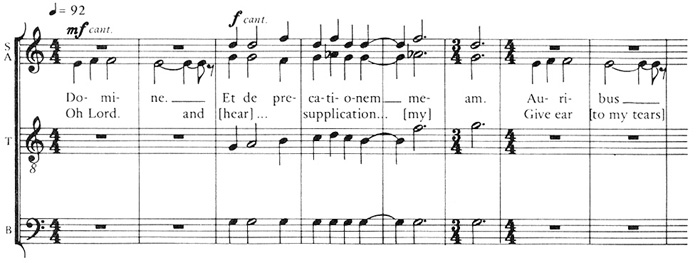
(Disjunct melodic contour, chromaticism, and large range to suggest "stranger.")
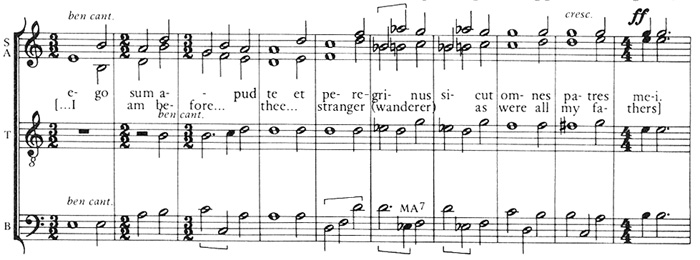
The first part of the second movement is a complex double fugue, the oboes opening with the subject of the instrumental fugue, the sopranos introducing the subject of the choral fugue. At 5, the text tells of the works of the Lord: "He inclined to me and heard my entreaty. . . . He guided my course. . . ." This section (5 - 14) ends with a diminuendo and is to be performed dolce cantabile, "mf," p ma marcato. Then, following a pause, the stretto, based on the instrumental subject, begins. The texture is dense, almost all the tones are accented and the timpani play for the first time, outlining a diminished triad. "Et immisit in os meum canticum novum . . . carmen Deo nostro" ["And placed in my mouth a new song . . . the song of our God"], the chorus sings "ff." The sudden change in texture, dynamics, instrumentation highlight the reference to the "new song."
As the third movement—the new song—begins, it is peaceful and serene. The psalmist sings the praises of the Lord: "Hallelujah, praise God in His sanctuary." Then another change occurs (5, third movement). The music becomes strong ("ff") as the whole orchestra plays. There are violent, rapid sweeps of triplet passages and glissandos. Immediately following this passage, at 6, the chorus sings again and the text explains the previous powerful measures: "Laudate Eum in virtutibus Ejus . . . multitudinem magni" ["Praise Him for his valor (His mighty acts) . . . abundant greatness"]. Tempo, melody, and orchestration have all combined to express the power, the valor, and the mightiness of the Lord.
Among other musical representations of specific words is the climactic use, at 11, of the full orchestra on the words "multitudinem magni" ["abundant greatness"] as they are sung "f" repeatedly, together with "Laudate Eum in sono tubae" ["Praise Him with sounds of the trumpet"]. These words are followed by a flourish on E-flat from the horns. The use of dynamics, full orchestration, and horns to indicate "abundant greatness" and "sound of trumpets" is obvious. According to Stravinsky, this section was inspired by a vision of Elijah's chariot climbing the Heavens. "Never before had I written anything quite so literal as the triplets for horns and piano to suggest horses and chariot," the composer said.18
Threni (id est Lamentationes Jeremiae Prophetae)19
Latin, Stravinsky wrote in his autobiography, is ". . . a medium not dead but turned to stone and . . . monumentalized."20Threni followed Oedipus Rex by about thirty years. The composer had developed an interest in atonality and an affinity for chromaticism. But some of the same techniques of word-music relationships are here as those used in the past.
In Memories and Conversations, published in 1959, shortly after the composer had completed Threni, the following dialogue is reported:
R.C. You often associate "pathos" with chromaticism. Do you really believe in this . . . association?
I.S. Of course not: the association is entirely due to conventions. . . . Nevertheless, "chromaticism" and "pathos" are connected.21
Stravinsky also suggested an association between "pathos" and chromaticism in Themes and Episodes, where he notes a plaintive quality which was first detected in the Orpheus music. ". . . But the quality I believe to be meant is, in fact, already present in my String Concerto,"22 he continues. He cites the two measures of the Concerto which contain the plaintive quality. They consist of a descending minor second melody in slow tempo accompanied by chromatic harmonies.
It is the descending minor second in slow tempo which provides the element of "pathos" in Stravinsky's example and it is the descending minor second which dominates a large part of Threni. This interval is used, on occasion, in conjunction with words specifying "grief" or "pathos" (e.g.: Measure 66—"Plorans ploravit" ["She weepeth sore"]; Measure 262—"Ocules meus afflictus est" ["My eye is afflicted, weeps"]; Measure 189—"recordare paupertatis" ["remembering affliction"]), and it also occurs repeatedly as a motif throughout the work. Its presence as introductory chant before many of the verses helps to create the feeling of desolation expressed by the text.
At the words "ut conteret sub pedibus" ["to crush underfoot"] in Measure 218, we find the piano used for the second time in the score, and the timpani join the piano as they play repeated E-flats. This is highlighted as the solo bass sings the first tone in falsetto voice and then in unison on the E-flat with the piano. The dynamics are subito p and the piano plays staccato. The E-flats are sung in steady, rhythmic eighth note patterns. The repeated low pitch performed by piano, timpani, and bass create a startling hammering effect. Thus, Stravinsky achieves the representation of "crushing underfoot" against the earth.
Later, as the singers cry out, "Tu inexorablis est" ["Thou art inexorable," "unforgiving," "relentless"] (Measures 244-45), repeated tones are used again. This time, they are sung "ff," the syllables accented, accompanied by strings, piano, and timpani. The strong dynamics and ostinati describe the idea of a relentless, unmoved God.
Immediately following this, at Measure 246, the second tenor sings "Operuisti in furore" ["Thou hast covered in fury"]. The melody is disjunct and is based on the opening motif of the descending octave plus semi-tone. This time, however, instead of the previous dynamics (f > p), every note is accented and the disjunct, anguished melody takes on a different quality. As the sopranos sing, "et percussisti nos . . . pepercisti" ["and persecuted us . . . (not) pitied"], the same sort of dynamics ("ancor piu f,"  , and accents) and disjunct melodic contour combine to portray the revengeful Lord.
, and accents) and disjunct melodic contour combine to portray the revengeful Lord.
Other word-music relationships can be found in this highly complex work. One finds use of accents to proclaim truth and hope. In Measures 205-7, for example, on the words "Bonus est Dominus sperantibus in Eum" ["Good is the Lord to hopers in Him"], accented repeated C's are sung Stesso,  = 208, by the altos against sustained E's played by tuba and flugelhorn. The phrase ends as the alto and tenor soloists outline the major triad. These measures, with their suggestions of major harmonies, appear to represent Stravinsky's portrayal of the ideas of "hope" and "good."
= 208, by the altos against sustained E's played by tuba and flugelhorn. The phrase ends as the alto and tenor soloists outline the major triad. These measures, with their suggestions of major harmonies, appear to represent Stravinsky's portrayal of the ideas of "hope" and "good."
A similar use of simpler harmonies occurs at the end of the "Oratio Jeremiae Prophetae" ["The Prayer of the Prophet Jeremiah"]. Here, the harmonic structure is used to express the words in a manner similar to that used by Stravinsky in Oedipus Rex (see Example I) when the Chorus cries out to Oedipus, "What shall we do . . . to be freed?" The text reads, "Converte nos Domine ad te, et convertemur" ["Turn thou us unto thee, and we shall be turned"]; "innova dies nostros sicut a principio" ["renew our days, as of old"] (Measures 405-419). This passage is a highly dissonant, chromatic one. But when the final words of Threni—"a principio" [''as of old"]—are reached, a final resolution of the whole composition to the "old" takes place. The only tones sung by the full chorus on the last syllable are E-flat and G-flat. There is a brief return to dissonance, another resolution, and the final tones of Threni are heard. They are A and C. The "old" is the modal—the minor third (see Example IV).
Ex. IV. (Final resolution to minor third from dissonance to represent return to "old.")
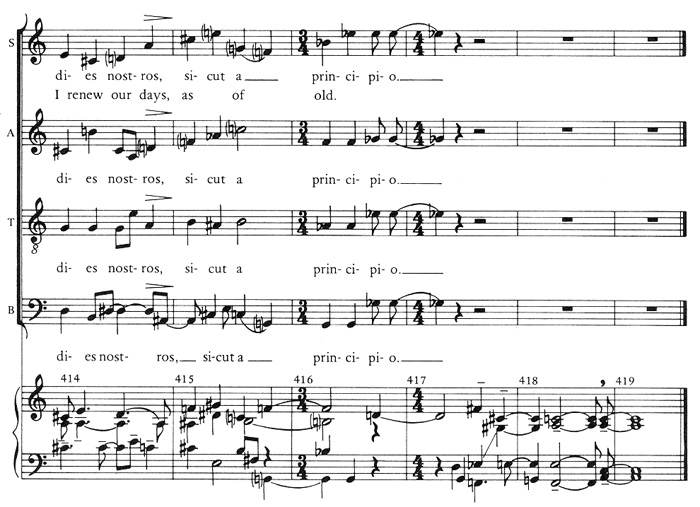
Canticum Sacrum23
In Canticum Sacrum, Stravinsky used serial techniques and the composer agreed with Robert Craft that the "choral canons [in that work] are much more difficult to hear harmonically than any earlier music [of Stravinsky's]."24 The word-music relationships are also more difficult to hear in this atonal work; nevertheless, some can be found.
As Canticum Sacrum opens with the "Dedication," it suggests Gregorian chant with a few added accidentals (Measures 1-9) and then becomes increasingly chromatic. In the third section, "Caritas," there are choral canons written in serial techniques. As the tenor sings of love in the highly chromatic second part, "Surge, aquilo," the melody is flowing and the undulant lines are sung  = 92, espressivo, dolce, cantabile.
= 92, espressivo, dolce, cantabile.
It is not until the fourth part, "Spes," that word-music relationships become close. This section uses twelve-tone techniques. It starts tranquillo, cantabile, non f, as the tenors and basses sing, "Qui confidunt in Domino" ["Who trusts in the Lord"] "sicut mons Sion" ["shall be like Mt. Zion"]. At the words, "be like Mt. Zion" (Measures 148-153), the performance style changes. The music is subito piu f, every tone is accented, and the accompaniment is played "poco marcato." The accents and dynamics help to denote the solidity and strength of Mt. Zion. (The return to "mf" immediately following at "Sustinuit anima mea" ["Sustain my soul"] highlights the importance of the preceding dynamics.)
The first words of the fifth section "Fides" are "Credidi" ["I believed"]. All voices sing the descending minor second, the "pathos" or "lament" motif. Over and over, we hear B-flat to A—ten times in all. The frequent use of this melodic fragment (which recurs three times in Measure 214) is explained starting at the end of Measure 221: "Ego autem humiliatus sum nimis" ["I was afflicted greatly"]. Although twelve-tone techniques are used in the major portion of this section, the descending minor second occurs repeatedly at the repetitions of "Credidi" (Measures 214, 227, 228, 230, 231, 234) and during the orchestral portion following (Measures 237, 238, 239, 244), emphasizing the pathos of the text.
Part IV of Canticum Sacrum is a dialogue between Jesus and the father of an afflicted child. Jesus declares, "If thou canst believe, all things are possible to him that believeth." "Et continuo exclamens pater pueri" ["And straightway exclaimed the father of the child"] continues the text. The music (Measures 274-278) becomes piu agitato at these words and it is performed piuttosto f e risoluto, the tempo increasing from  = 88 to
= 88 to  = 96. Here, Stravinsky uses dynamics and tempo to indicate "exclaiming," "crying out." ". . . Cum lacrimis aiebat" ["With tears he said"] follows, Doppiamento lento,
= 96. Here, Stravinsky uses dynamics and tempo to indicate "exclaiming," "crying out." ". . . Cum lacrimis aiebat" ["With tears he said"] follows, Doppiamento lento,  = 96, the tempo change indicating the changing mood of the words (Measures 279-280). Then, "Credo, credo, credo, credo, Domine," the father (baritone soloist) sings. "Adjuva, adjuva, adjuva, adjuva incredulitatem meam" ["I believe . . . oh Lord; Help . . . my unbelief"]. The descending minor second recurs during the passage (Measures 284-287, 295, 303) as the father declares that he believes, knowing that he does not and pleading with God to help him believe. There are few texts more pathetic than this. Stravinsky has captured the anguish and pathos through his use of chromaticism, and, especially, through the use of the minor second combined with a slow tempo (
= 96, the tempo change indicating the changing mood of the words (Measures 279-280). Then, "Credo, credo, credo, credo, Domine," the father (baritone soloist) sings. "Adjuva, adjuva, adjuva, adjuva incredulitatem meam" ["I believe . . . oh Lord; Help . . . my unbelief"]. The descending minor second recurs during the passage (Measures 284-287, 295, 303) as the father declares that he believes, knowing that he does not and pleading with God to help him believe. There are few texts more pathetic than this. Stravinsky has captured the anguish and pathos through his use of chromaticism, and, especially, through the use of the minor second combined with a slow tempo ( = 60) and expressive performance (quasi rubato, con discrezione e non f).
= 60) and expressive performance (quasi rubato, con discrezione e non f).
Conclusions
Five works by Igor Stravinsky in which he used Latin texts—Oedipus Rex, Symphony of Psalms, Threni, Canticum Sacrum, and Mass25—were analyzed to determine whether the composer related specific words of the texts and the music. Each of these compositions stems from a different period of the composer's creative life, ranging from the Neo-Classical Oedipus to the serial Canticum Sacrum. Specific word-music relationships were not found by this writer in the Mass, but in the other settings of Latin texts considered by this writer, Stravinsky does use some conventional and traditional methods of associating words and music.
Dynamics and melody are the two most frequently used parameters of composition in Stravinsky's literal musical representation of words in the works studied. Stravinsky believed melody to be the most essential of musical elements, ". . . not only because it is more immediately perceptible, but because it is the dominant voice . . . not only in the specific sense, but also figuratively speaking."26 He appears to have felt the need for melodic expression outside the practices of serial composition, as in Canticum Sacrum, and in the highly chromatic Threni. In both of these works, Stravinsky returned to repeated use of the descending minor second, a motif used frequently in music history by other composers to denote pathos, anguish, and grief.
Of dynamics, Stravinsky declared, "My musical structure does not depend on dynamics—though my 'expression' employs them."27 Nevertheless, he also wrote that the gradations in volume (in Oedipus) are structurally important28 and that "the Oedipus singer must exploit dynamic contrasts. . . ."29 The numerous and precise, careful dynamics indications throughout all of these works must all be followed to achieve a valid performance. As demonstrated in this study, it is through the dynamics that the music becomes both . . . word and action."30
A good deal of the commentary on Stravinsky's works has been of a general nature with writers stating that he either did or did not carry out in his musical compositions the precept that music is powerless to express anything and that it is not within the realm of music to express the meaning of the text of song. The analysis undertaken here has determined that there are word-music relationships in selected settings of Latin texts with specific devices used in association with specific aspects of the text. In these works, at any rate, Stravinsky was concerned with the expression of the thoughts, moods, and words of the text.
The composer's use of these word-music relationships, however, does not, in and of itself, disprove his claims and belief in the non-expressive power of music. He saw these purely musical techniques as "conventions," which, "unconsciously or by force of habit," we have "lent to music," "thrust upon it."31 Nevertheless, the results of this study clearly demonstrate that he did, at times, use conventional methods of relating words and music.
The important position that works such as Oedipus, Threni, Symphony of Psalms, and Canticum Sacrum occupy result from all the devices, and all the originality, power, and magnificence the composer brought to them.
1Warren Dwight Allen, Philosophies of Music History (New York: Dover Publications, Inc., revised, 1962), p. 299.
2Ibid., p. 303.
3Leonard B. Meyer, Emotion and Meaning in Music (Chicago: University of Chicago Press, 1966), p. 6.
4Igor Stravinsky, An Autobiography (New York: Simon and Schuster, 1936), p. 83.
5Igor Stravinsky, Poetics of Music, trans. Arthur Knodel and Ingolf Dahl (New York: Vintage Books, 1947), p. 46.
6Igor Stravinsky and Robert Craft, Expositions and Developments (New York: Doubleday and Company, 1962), p. 101.
7José Rodriguez, Chapter 8, Igor Stravinsky: Articles and Critiques, ed. Merle Armitage (New York: G. Schirmer, Inc., 1936), p. 43.
8Stravinsky, Autobiography, p. 202.
9Ralph E. Hart, "Compositional Techniques in Choral Works of Stravinsky, Hindemith, Honegger, and Britten" (unpublished doctoral dissertation, Northwestern University, 1953), pp. 153-54.
10Alexandre Tansman, Igor Stravinsky—The Man and His Music (New York: G.P. Putnam's Sons, 1949), p. 20.
11Nicolas Slonimsky, Music Since 1900 (New York: Coleman-Ross, 1949), p. 291, citing A. Schaeffner, Stravinsky, 1931.
12Igor Stravinsky and Robert Craft, Dialogues and a Diary (New York: Doubleday and Company, 1963), p. 14.
13Igor Stravinsky and Robert Craft, Conversations with Igor Stravinsky (New York: Doubleday and Company, 1959), p. 35.
14Igor Stravinsky and Jean Cocteau, Oedipus Rex (London: Boosey and Hawkes, Ltd., 1949). A detailed analysis of other aspects of text-music relationships is presented in this author's doctoral dissertation, "Greek Tragedy in Theatre Pieces of Stravinsky and Milhaud" (New York University, 1968), pp. 157-222.
15An italicized digit indicates the rehearsal number in the score. The second digit indicates the measure count of the rehearsal section.
16Stravinsky and Craft, Expositions and Developments, p. 108.
17Igor Stravinsky, Symphony of Psalms, new revision (London: Boosey and Hawkes, Ltd., 1948); composed 1930.
18Stravinsky and Craft, Dialogues and a Diary, p. 46.
19Igor Stravinsky, Threni (id est Lamentationes Jeremaie Prophetae) (London: Boosey and Hawkes, Ltd., 1958).
20Stravinsky, An Autobiography, op. cit., p. 195.
21Igor Stravinsky and Robert Craft, Memories and Commentaries (New York: Doubleday and Company, 1959), p. 111.
22Igor Stravinsky and Robert Craft, Themes and Episodes (New York: Alfred A. Knopf, 1966), p. 46.
23Igor Stravinsky, Canticum Sacrum (London: Boosey and Hawkes, Ltd., 1956); composed 1955.
24Stravinsky and Craft, Conversations with Igor Stravinsky, p. 25.
25Igor Stravinsky, Mass (London: Boosey and Hawkes, Ltd., 1948).
26Stravinsky, Poetics of Music, p. 43.
27Stravinsky and Craft, Conversations with Igor Stravinsky, p. 151.
28Igor Stravinsky, program notes, Oedipus Rex, Stravinsky, recording, Columbia Masterworks, ML 5872, 1963.
29Stravinsky and Craft, Dialogues and a Diary, p. 13.
30Stravinsky, An Autobiography, p. 195.
31Ibid., p. 83.


